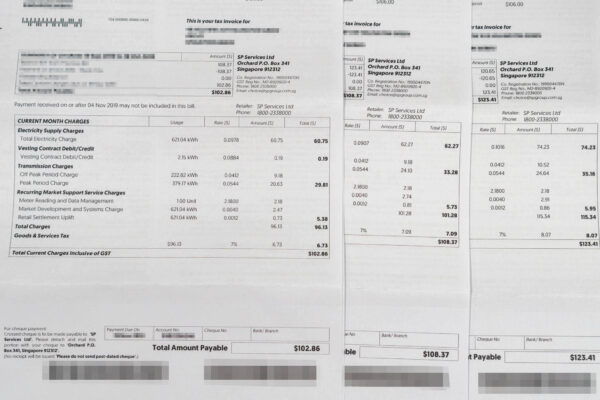
It’s been just a little over a year since retail electricity became available to residential consumers. I originally signed up with Geneco on a short six-month contract, then decided to quit and return to SP Services, not on their regulated tariff plan, but on their wholesale plan. It seems to be working out.
Prior to last November, apart from a limited Open Electricity Market trial, residential consumers had to buy their electricity from SP Services on a regulated tariff basis. When the electricity opened up, we saw that prices from the retail electricity sellers were lower than the regulated tariff. I suppose that is to be expected, otherwise residential electricity consumers would simply stick with SP Services.
Something that many residential electricity consumers might not know is that SP Services had an alternative option to the regulated tariff plan. They do have a wholesale electricity plan for the small customers like us.
SP Services’ Wholesale electricity plan means you get charged the wholesale electricity rate, the same rate (in principle) at which retailers get their electricity. This rate fluctuates on a half-hourly basis. At the simplest level, this is about supply and demand.
The actual wholesale electricity rate is very little, typically something like under 10 cents per kWh. Contrast this to the present 23.43 cents per kWh (excluding GST). I know this sounds extremely good, but that’s now the whole story. Wholesale electricity comes with a lot of other price components that you need to pay separately. These are:
- Vesting Contract Debit/Credit: Variable
- Transmission charges: two different rates, 4.12 cents per kWh for off-peak hours and 5.44 cents per kWh for peak hours
- Meter Reading and Data Management charge: $2.18 per meter
- Market Development and Systems charge: 0.4 cents per kWh
- Retail Settlement Uplift: 0.12 cents per kWh
All the components above, except for the first one (i.e. Vesting Contract Debit/Credit), are rates that are known up-front. Like the regulated tariff, the price may change from time to time, but the rates are published beforehand.
The Vesting Contract Debit/Credit component is variable, and the amount is not known until after you have consumed electricity. Vesting Contracts are bilateral agreements between power generation companies and the Market Support Services Licensee (presently SP Services) that mandate a specified amount of electricity to be hedged at a specified price. This is done in order to mitigate against larger power generation companies influencing market prices by withholding supplies.
For consumers new to wholesale electricity plans, this unknown Vesting Contract Debit/Credit component can be rather worrisome. The component, however, is small. It works out to be under 20 cents per month. Sometimes it can be zero.
How has my electricity prices been like while on this wholesale electricity plan? Well, everything in, I average about 16 cents per kWh, inclusive of GST.
You don’t get it cheaper from any other electricity retailer.
Of course, in the big picture, you may also want to compare the incentives offered by electricity retailers in the Open Electricity Market, such as discounts, bonuses when you recommend friends, or rebates from bundling other services, etc.
SP Services’ wholesale electricity plan is standalone, and they are disallowed by the energy market regulator from bundling services or offering promotions. The good thing, however, is that there is no contract. You are always free to change any time.
The wholesale electricity plan has offered me the best value every month. I may be disadvantaged if some day wholesale market prices skyrocket, compared to having been riding on a long-term contract that had been locked to a very low price. I’m betting this is unlikely to happen, and even if so, I could still switch retailers, though granted new contract prices won’t be as cheap as before if present market trend is going upward.
Wholesale electricity being priced every half-hourly also has the advantage that you can plan your high electricity consumption during low price periods. You won’t know the prices up front, but you do get a forecast indication from the Energy Market Company’s Price Information webpage. Do note that forecast prices are not finalised; the final price settlement comes about a week or so later.
If you’re interested to get on this wholesale electricity plan, here’s what you need to do:
- If you are still on the regulated tariff, just head to SP Utilities Portal and look for the option to switch to the wholesale electricity plan.
- If you are already on one of the electricity retailers in the Open Electricity Market, you need to tell your present retailer that you want to quit and return to SP Services’ wholesale electricity plan. It took me quite a long while to quit Geneco (almost a month), so be prepared to plan your exit ahead of time.
Even if not required, it is best to get the new smart meters (Advanced Metering Infrastructure), which records your electricity consumption in real time. This allows SP Services to bill you according to your actual half-hourly consumption. Otherwise, you will be billed based on a presumed national consumption profile, which may work for or against you.
(Note: In the bill sample above, for simplicity, SP Services simply shows a single kWh rate for the electricity charge. With a smart meter, the true half-hourly consumption information can be downloaded from SP Utilities Portal.)
Update: How Is Wholesale Electricity Doing? (25 Sep 2021)
